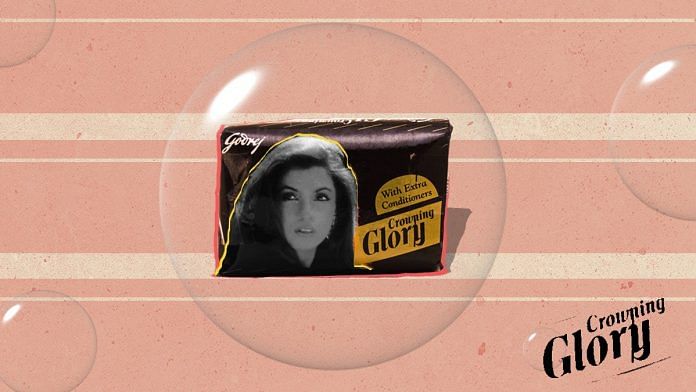Godrej’s soap-cum-shampoo Crowning Glory may have disappeared, but memories of its ad remain.
How often does an advertisement become successful, but the product just bombs in the market? A classic example of this is a soap called Crowning Glory. More Indians actually remember the advertisement featuring Bollywood actor Dimple Kapadia than the soap itself.
This was the 1980s – and the soap was made by Godrej. The commercial had Indians abuzz.
Positioned as a soap-cum-shampoo for women, it coincided with Dimple Kapadia’s comeback years. And the ad was a bold break from the routine sanskari, sari-clad, bindi-and-sindoor wearing, ritual-following woman.
Also Read: Binaca was a brand that brought toothpaste and music together
“It was perhaps the beginning of an era when vanity came out of the closets… moving away from the shringar culture, especially on television,” brand guru Harish Bijoor said.
At a time when celebrating sexuality almost seemed to be a crime, Dimple Kapadia added a certain sizzle and zing to the advertisement.
The bold Kapadia in the swimming pool smashed the contours of social norms, Bijoor added.
“It reflected a modern India, an India where women did not necessarily have to adhere to the so-called traditional sanskar.”
The television commercial was an instant hit.
It came just after the Cinthol advertisement, which featured current Pakistan Prime Minister and former cricket icon Imran Khan as the handsome alpha male.
The ad, shot by Zafar Hai, was personally crafted and supported by the late Parameshwar Godrej.
Young men and women waited for the advertisement, but not without inhibitions.
“Those days the ad was almost like soft -pornography material…I remember my father switching off the television when the ad would appear…he was almost embarrassed watching the ad in front of his children,” Anirban Dasgupta, who grew up in Patna, recalled. “The social structure and norms were very different, especially in the smaller cities.”
The late Alyque Padamsee, who made the Liril advertisement showing a girl merrily bathing in a waterfall around the same time, had told ThePrint that the change in the advertising strategy started during that period and, in a way, changed India.
Also Read: Campa Cola was India’s answer to Coca-Cola and was the perfect fit.
“We started making bold ads and somewhere the message was that it was absolutely fine not to adhere to norms, or let me put it like this, the accepted norms of that time,” he said, just a few weeks before he passed away.
However, Padamsee had also said that a good and catchy ad can only support a brand and give it the required publicity. “Finally no matter how much you advertise or how well your ad is, if your product is not good or competitive, it will die,” he said.
This seems to have been the case with Godrej’s Crowning Glory.
Bijoor explained that in the case of Crowning Glory, the most important feature was the personality endorsing it, then the concept, and then came the product.
Godrej did not officially comment on the issue. However, a company executive said that the product was withdrawn by mid-2000s from the market, but it continued to be selectively sold in a few pockets of the country till the turn of the decade.
“It has, however, now been completely discontinued…it wasn’t because the product was not doing well, but you need to keep changing with the needs of the market,” the official said.
Crowning glory faded into oblivion, but the memories of the ad still linger in nooks and crannies.
Also Read: ‘Livva little hot’ Rekha, a cola war and the zing thing: Remembering Gold Spot






